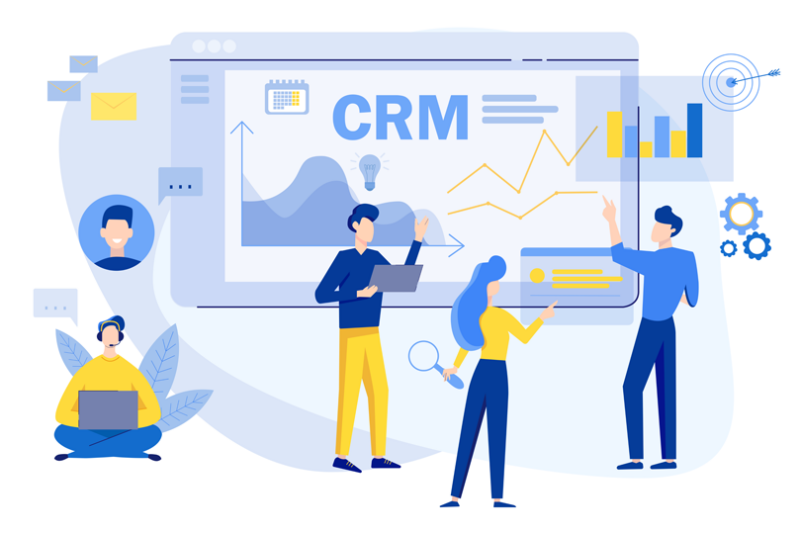What does it take to make a CRM project successful? A best-of-breed CRM system? CRM technical expertise? A detailed implementation plan?
All of these are essential, but they aren’t sufficient to guarantee rapid results, let alone long-term success. They are prerequisites for managing the technology and your processes, but these elements alone don’t reflect the importance of managing the people involved in the project.
We’ve encountered businesses that invested in CRM systems ideally suited to the organisation and its processes, but the results fell way short of expectations.
All too often, that’s due to business leaders’ belief that people will immediately embrace a new system.
If the technology is good and resources are available, people should use it, right?
While that might be true for other applications, the reality is often different for CRM. Where problems arise, they are almost always caused by a disconnect with users.
A CRM project should begin with a leadership vision of where you want to be. It is critical that all the key executives are involved in defining your vision, that you document it, and that it is understood by and communicated to everyone in the business.
From the outset, CRM is a tool for leadership, so getting people on board is essential for success. Users must be aware of your vision, why there is a need for a new CRM system, why it matters, what CRM success looks like, and, crucially, how they can help.
Poor user acceptance and a lack of internal leadership are surefire ways to undermine a CRM initiative resulting in wasted project costs and demotivated team members. For CRM to fulfil its potential, the new system must meet the needs of its users, and teams must understand how to use it.
Below, we’ve shared 11 leadership recommendations to underpin a successful CRM project:
1. Show people the direct benefit of CRM
You can’t assume that your people will have the same passion for making your business processes more cost-effective as you.
Using the example of a sales team, they care about their sales commission. Sellers should be aware of the CRM benefits, not just to the company, but to them personally (improved productivity, increased win rate, shortened sales cycle, better lead quality, less administration). Demonstrate that a new system will make their working life more manageable.
2. Start with priority teams
Where will a new system have the most significant impact on your business?
A phased implementation begins with one or two teams where the most significant gains can be made, avoiding the expense of a long, drawn-out project.
As well as lowering the upfront expense of CRM, a small-scale initial implementation will quickly get the technology into the hands of users, enabling them to build confidence and see early benefits.
3. Build a strong project team
Your project team should include the following members:
- An Executive Sponsor who lends their influence to the project by becoming its champion at a board or senior management level. Their support and participation in CRM planning to go live and beyond is critical.
- An Internal Project Manager who understands your business’s process to lead your project from an “in-house” perspective.
- At least one person will be designated as a CRM Administrator to manage the system. These individuals will ideally be technical and well-organised, responsible for adding users, managing security roles, importing data and providing front-line user support.
- To ensure that your CRM system meets the needs of your teams, Key Business Users should be included in the project team and involved throughout the planning process. They will be team leaders and influential individuals within your organisation who people respect. Getting these people on board is crucial.
4. Create a training plan
If individuals don’t learn how to use the system, it sits untouched. Sales and other teams will quickly fall back into their old ways of finding information in spreadsheets and other disparate systems or revert to manual processes.
Employees can’t be given a one-off training session and instantly be expected to become highly proficient users. A leading package like Microsoft Dynamics 365 and the cloud platform it runs on may be intuitive to use, but it contains advanced functions where role-based training and follow-up sessions will be beneficial to individuals.
Demonstrate its importance by allocating time for training sessions and developing training plans for individual roles that will support continued learning and create advocates. Provide plenty of notice for training and for in-person sessions, deliver training in an environment free of interruptions.
5. Communicate CRM isn’t optional
Your company has invested time and hard-earned money in CRM. Usage is not optional and nor is failure.
CRM implementation will likely prove disruptive to settled practices and result in change, but if these processes were fully efficient, there wouldn’t be any need to implement a new solution!
Communicate that this initiative is not business as usual and that CRM cannot be ignored.
6. Leaders must use CRM
Few things undermine a CRM project as much as an executive who bangs the drum for CRM in the early days but doesn’t use it themselves.
Leaders initiate CRM projects, and they will reap the benefits of the technology. But if the system is to be ingrained into the culture of the business, its leaders must be committed and conspicuous users.
7. Use CRM data in meetings
CRM helps people prepare for meetings and be more informed, whether they are leaders or participants.
Quote CRM data and use these metrics as the basis for reporting, discussing and celebrating achieving goals.
For example, a service team leader can share CRM data to report logged cases, commend the individuals who resolved most issues and pinpoint which service issues are consuming the most time.
8. Embrace CRM change
Your company and industry don’t remain unchanged, nor should your CRM system.
A healthy sign is when users request changes and seek improvements, especially in response to changing client requirements and competitor activity. If your team isn’t pushing for CRM change, they are unlikely to be getting value from it.
CRM is not a “fit & forget” system. Effective CRM strategies will continually evolve. After deployment, develop a systematic process to invite user suggestions and evaluate requests to make further improvements to the effectiveness of CRM.
Some requests can’t be actioned immediately, and some ideas may be impractical. It’s another example of where leaders must manage expectations and communicate why specific requests cannot be immediately progressed.
Aside from user-driven requests, CRM change can also result from acquisitions/mergers, adding new services/products, expansion into new territories and other milestone events.
Changes will also arise from technology updates. Monitor new feature releases to understand and communicate how the latest releases can be effectively used.
In larger organisations, a CRM steering group is often assembled. They have representation at the board level and meet regularly to discuss, plan and implement CRM change in a controlled manner. For smaller businesses, this might be just one or two individuals that assume ownership and coordination of CRM with business goals.
9. Strive for CRM integration
Doing the same thing in different systems is a productivity killer. A successful strategy aligns processes so they can manage through a single interface.
Leaders should continually look to identify and eliminate duplication of effort by integrating processes with CRM. In some instances, CRM can replace legacy spreadsheets and applications, while in other cases, it will integrate with specialist systems and services, including ERP and marketing automation platforms.
A fully integrated solution gives teams more time to do their job, improves efficiency and prevents users from seeing CRM as another disconnected system that needs updating.
10. CRM means collaboration
Finally, never lose sight of the fact that your CRM software should foster collaboration between teams to modernise your processes and make improvements to service delivery.





